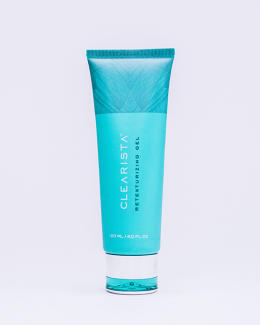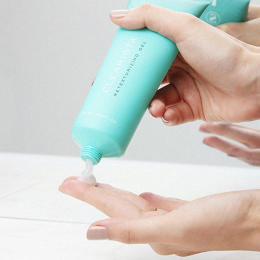When the CIA invested in a skin care brand, some hoped the agency was taking on that particular scourge of beauty terrorism: wrinkles.
In fact, it was the CIA’s venture capital fund, In-Q-Tel, which invested in Skincential Sciences, a company best known to consumers for its patented skin-smoothing gel Clearista—a popular cosmetic product that’s been hailed by beauty bloggers and dermatologists alike.

Founded in 2010 as a medical diagnostics company, Skincential’s goal was to find a way to release and collect certain biomarkers from human skin. “Your biomarker profile can reflect a number of things—where you’ve been, what you’ve done, who you are,” explained Russ Lebovitz, CEO of Skincential Sciences.
Just as the microbiome of a person’s gut has become an area of intense interest to researchers (and even the White House), the microbiome of the skin can be analyzed to detect everything from chronic skin conditions and cancer to a person’s geographic history. The trouble is that the skin is a notoriously difficult surface to gather biomarkers from.
There are three common ways to collect biomarkers from the skin, says Lebovitz: biopsies (“which is very invasive”), skin scraping (“you can accidentally go very deep”), and variations of Scotch tape (“but it can be hard to recover DNA from tape”).
During early tests of their biomarker harvesting product, Skincential’s scientists feared that the product would irritate skin. Instead, they discovered just the opposite: Their test subjects enthusiastically approached researchers following test studies. “The response we got from almost every [test subject] who used it was, ‘Whoa, this made my skin feel really smooth. Not only is this not irritating, it changed the way my skin feels and reflects light,’” recalled Lebovitz, who compared the product’s gentleness to baby shampoo. “That was an aha moment for us.”
The business quickly made a sharp right turn, bottling up its skin-lab potion and marketing it to mature women. But moving into the consumer cosmetics space was a costly proposition, and the investors had to be won over. “This is a business that generally requires a lot of marketing dollars, and we haven’t had those,” he said. “We had to do the groundwork.”
The investors also knew that creating a medical product would cost tens of millions of dollars through a formal regulatory process that would take three years, at best. “I wouldn’t say our investors were skeptical,” said Lebovitz, who appealed to investors to give him one year to develop a prototype with investment dollars, “but they wanted to see what we were doing at every step.”
Through word of mouth and cold-sending products to beauty editors and influential beauty bloggers, Clearista gathered a loyal and rapidly growing following of fans who lauded the product for its ability to minimize the appearance of fine lines, smooth rough patches, and brighten skin spots. As Lebovitz explains, it’s like taking skin texture from linen to silk.
They began selling exclusively on the web, but then found that when products were used more aggressively by professionals, the results were far more successful. And so they branched out into medical spas.

Dermatologists can increase the product’s intensity with amount applied and time spent scrubbing. Penny Johnson, a licensed medical aesthetician from the O’Connell Dermatology practice in Torrance, Calif., recommends Clearista to clientele looking for tailored, noninvasive treatments. “There’s a whole combination of things that [Clearista] can do that’s a lot more in detail versus the competition,” she said of the product, used for both skin abrasion removal and antiaging facial treatments. “It lets you customize for each specific person,” she explained, noting that customers don’t want “a cookie-cutter deal,” but rather something that’s specifically beneficial to them. “No one person is the same.”
It’s an opportunity Skincential Sciences is acutely aware of. While the cosmetic industry has made significant strides in science, each year brings new levels reached in terms of clinical results.
And consumers are noticing, explained Karen Grant, global beauty industry analyst of the NPD Group. “Today, brands offering the efficacy of scientific research and those offering the safety of natural (or a combination of the two) are at the forefront of the market in driving trends and growth,” Grant said of the U.S. beauty market, which according to NPD’s most recent estimate, generated sales of $48 billion in 2014. Brands identified as clinical/cosmeceutical grew 10% in facial skin care sales over the previous year, while the overall prestige facial skin care market grew by only 1%.
After registering their patents in 2013 and further optimizing their product, they pivoted to focusing entirely on skin care. “We came to realize the power of what we had created, and that while it was now great for something diagnostic, it was also great to just apply directly to the skin.”
But product sales are only skin deep for Skincential Sciences. More than anything, the company aims to change the way skin care markets, driving a more scientific approach to it all. Moving forward, Skincential plans on “dramatically” expanding their line, launching new products based on the same chemistry but using different formulations, such as serums for sensitive skin.
“We have a product that in the hands of someone who had a bigger budget and already had channels could be selling a lot more without really even changing the product,” Lebovitz said.
At the same time, because the original IP is protected, Skincential could be a licensing gold mine. “A skin care company might look at this a little more like a medical product,” said Lebovitz, “and say, “We can build 20 products around this.'”
Related Video: Why The Founder And CEO Of The Nonprofit Samasource Started A Luxury Skincare Line
Fast Company , Read Full Story
(13)